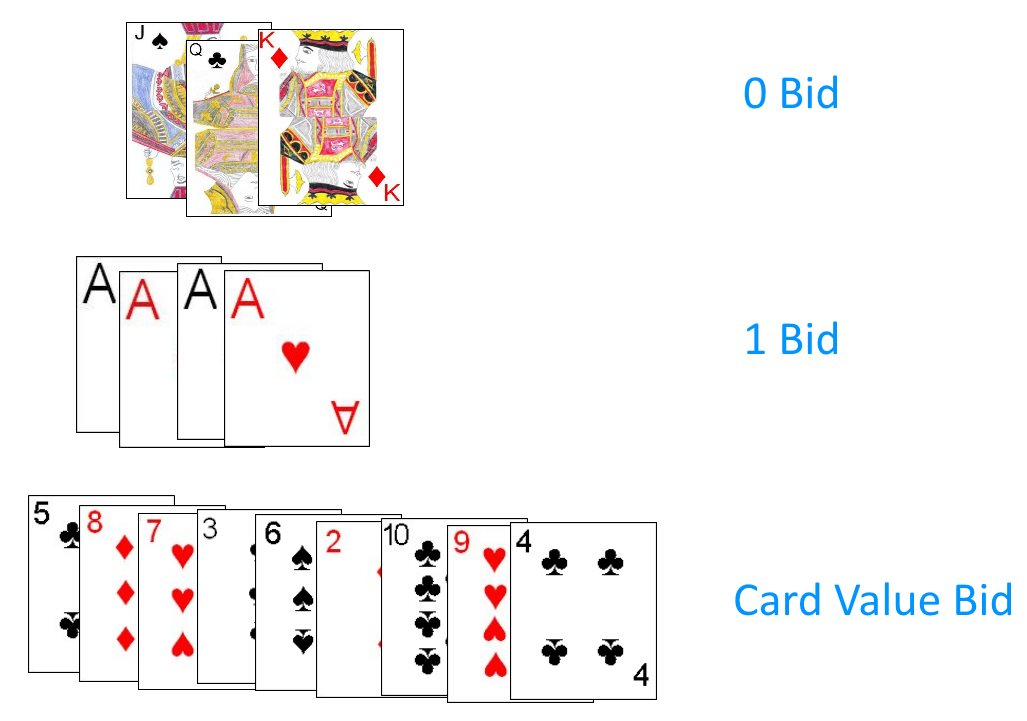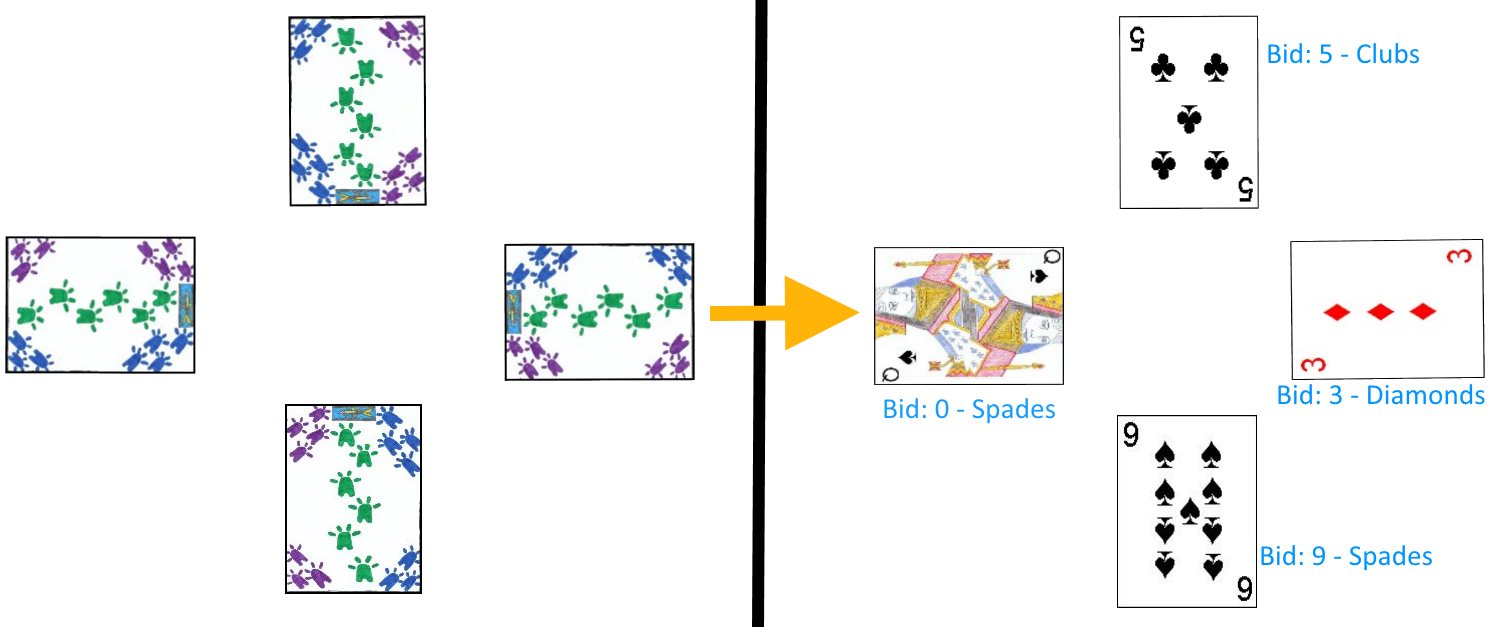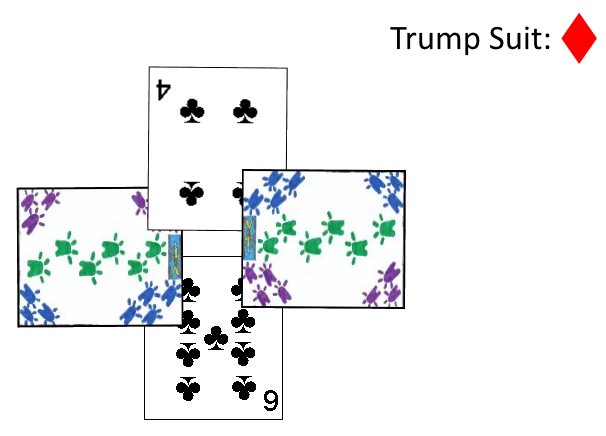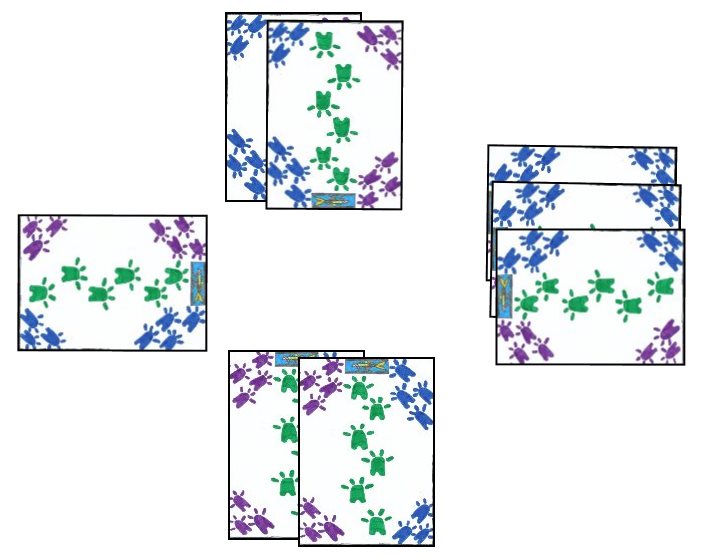Truf is designed to be played by 4 players each playing independently, but a variant for three players is described in the variations section below. The game is played using one standard 52 card deck. The ranking of the cards in the game Truf is as follows (from highest to lowest); Ace, King, Queen, Jack, 10, 9, 8, 7, 6, 5, 4, 3, 2.
 Determination of the seating positions and the first dealer can be performed using a variety of methods, with drawing for high cards very common. Players each draw a card from the shuffled pack and take seats in the order of cards drawn, from highest to lowest. If multiple players draw cards of the same rank, those players should discard those cards and draw another, continuing this until they have each drawn a rank which is not previously drawn by another player. The player drawing the highest ranked card of all is set as the first dealer.
Determination of the seating positions and the first dealer can be performed using a variety of methods, with drawing for high cards very common. Players each draw a card from the shuffled pack and take seats in the order of cards drawn, from highest to lowest. If multiple players draw cards of the same rank, those players should discard those cards and draw another, continuing this until they have each drawn a rank which is not previously drawn by another player. The player drawing the highest ranked card of all is set as the first dealer.
Once the first dealer has been determined, that player should thoroughly shuffle the cards and offer the deck to the player at his left to cut. The dealer finishes the cut and begins the deal. He deals in a counter-clockwise direction around the table, one card at a time and face-down, starting with the player to his immediate right. He continues dealing until the entire deck has been dealt out, each player receiving 13 total cards. Each deal alternates between being dealt clockwise and counterclockwise as does the rotation of play during the hand. Thus, the first hand would be dealt and played in a counter-clockwise direction while the second hand in a clockwise direction, alternating in this way after each hand.
After the deal, if any player finds that his hand consists entirely of number cards (2, 3, 4, 5, 6, 7, 8, 9, 10) or entirely of court cards (Jack, Queen, King, Ace), he must show the hand, which nullifies the current hand. In that case, all the cards are thrown in and a new hand is dealt by the same dealer.
The Bidding: If no player is able to (or elects not to) throw in his cards to nullify the hand, it is played out, which begins with the bidding. The bidding consists of each player simultaneously selecting one card from his hand and placing it face-down in front of himself to represent his bid. The ranking of the card played will represent the number of tricks he intends to win, with the suit of that card representing the suit that would be used as the trump suit. The following chart indicates the bidding value for the card bid:
| Bid Card | Representative Value |
|---|---|
| Jack, Queen, King | 0 Tricks |
| Ace | 1 Trick |
| 2, 3, 4, 5, 6, 7, 8, 9, 10 | Same Number of Tricks as the Ranking of the Card (2 - 10) |
 When each player has selected the card, all bid cards are turned over simultaneously. The suit of the highest ranking bid card sets the trump suit to be used for the hand. If two or more players tie for this highest bid, the suit of each tied card is then ranked, from high to low; Spades, Hearts, Diamonds, Clubs.
When each player has selected the card, all bid cards are turned over simultaneously. The suit of the highest ranking bid card sets the trump suit to be used for the hand. If two or more players tie for this highest bid, the suit of each tied card is then ranked, from high to low; Spades, Hearts, Diamonds, Clubs.
If the total sum of all bids by the players is greater than 13, the object of each player is win as many tricks as possible during the hand. This is called a Main Atas game.
If the total sum of all bids by all four players is less than 13, the object of each player is to win as few tricks as possible during the hand. This is called a Main Bawah game.
If the total sum of bids by all four players equals exactly 13, the player with the highest bid must elect to either increase or decrease every bid by an equal amount (including his own). He thus indicates if he intends to increase or decrease the bid and indicates by how many. Each player's bid (including the high bidder's own bid) is then automatically increased or decreased by that same amount as specified by this player. This adjusted bid is then considered that players bid for the current hand. Note that in the case of a decrease it is possible for a player to actually end up with a negative bid. As in a standard bid, if the player elects to decrease the bids, players attempt to win as few tricks as possible and if the high bidder elects to increase the bids, the players attempt to win as many tricks as possible.
Once the bidding, trump suit and game type is determined, each player adds his bid card back into his hand and play begins.
 The player who had the high bid leads the first card to the first trick. Each other player in proper rotation then contributes one card from his own hand to the trick. If a player has a card of the suit originally led to the trick he must play it. If he has no such card he may play any card from his hand to the trick, including a card of the trump suit. The winner of each trick leads the first card to the next trick. If no card of the trump suit has yet been played to a trick during the current hand, the leader to the trick may not lead with a card of the trump suit (unless the only cards he has remaining in his hand are cards of the trump suit). Any time any card of the trump suit is played to a trick (leading or otherwise), this card is played face-down to the trick. After all players have played to the trick, any face-down cards played to the trick are then exposed to determine the winner of the trick.
The player who had the high bid leads the first card to the first trick. Each other player in proper rotation then contributes one card from his own hand to the trick. If a player has a card of the suit originally led to the trick he must play it. If he has no such card he may play any card from his hand to the trick, including a card of the trump suit. The winner of each trick leads the first card to the next trick. If no card of the trump suit has yet been played to a trick during the current hand, the leader to the trick may not lead with a card of the trump suit (unless the only cards he has remaining in his hand are cards of the trump suit). Any time any card of the trump suit is played to a trick (leading or otherwise), this card is played face-down to the trick. After all players have played to the trick, any face-down cards played to the trick are then exposed to determine the winner of the trick.
After all tricks have been played and won, scoring for the hand occurs. The scores are determined for each player as follows:
- If the game was played at Main Atas:
- If a player wins fewer tricks than bid he scores a number of negative points equal to the difference between the number of tricks won and the number of tricks bid by that player.
- If a player wins more tricks than bid he scores a number of positive points equal to the difference between the number of tricks won and the number of tricks bid by that player.
- If a player wins exactly as many tricks as bid he scores 0 points for the hand.
- If the game was played at Main Bawah:
- If a player wins fewer tricks than bid, he scores a number of positive points equal to the difference between the number of tricks won and the number of tricks bid by that player.
- If a player wins more tricks than bid, he scores a number of negative points equal to the difference between the number of tricks won and the number of tricks bid by that player.
- If a player wins exactly as many tricks as bid, he earns 0 points for the hand.
The game continues for 13 hands, after which the scores are compared and the player with the highest accumulated total is declared the winner of the game.
 Multi-Card Bidding: In some games, players prefer to allow more than one card to be played during the bidding phase of the game. In this case, the sum of all cards bid by that player are added together to determine that players bid. However, there are also some stipulations on these cards. If a player's bid consists of two cards his total bid must equal at least 5 and a bid consisting of three cards must total at least 9.
Multi-Card Bidding: In some games, players prefer to allow more than one card to be played during the bidding phase of the game. In this case, the sum of all cards bid by that player are added together to determine that players bid. However, there are also some stipulations on these cards. If a player's bid consists of two cards his total bid must equal at least 5 and a bid consisting of three cards must total at least 9.